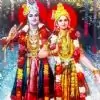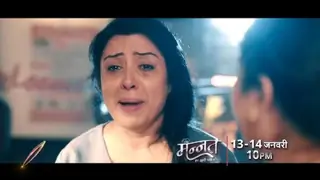1. Tauhid (Din) i Illahi of Akbar
2. Pranamis and Mastani
3. Antiquity of Vaishnavism in Rajasthan / Krishna Worship
4. How and when did Rajputs got influenced by an alien culture.
5. Coronation of Shivaji - His title Chhatrapati.
6. Annapurana Bai, Rakma Bai
7. Triambak Rao Pethe, Hyder Ali, Peshwa Madhav Rao
^^Yes went through the missed posts speedily. Though I have to re-read them in details. :)
The after leap episodes were amazing. Initially there was hitch on Karan's part but now he seems to be at ease. I found him initiating Ranveer in certain scenes but that done and dealt with. The major fact that works in his favour is his resemblance to Rudra. The casting is perfect when it comes to both Bajirao and Kashibai but unfortunately the characterisation is poor to a point it feels pathetic.
I have no issues with Kashi Bai as of now. The grown up Kashi's characterization is such a relief when compared to her younger counterpart. Contrast - First Kashi (Deepali Borkar) with this grown up Kashi. Lol.Just see her (Kashi's) expressions. This is how a person behaves - so much pain and love was in her eyes when she saw Bajirao. This is how a 20 something young lover would be on getting a glimpse of her love. She's turning out to be the best character post leap.The soft aspect of Bajirao in front of Kashibai is missing so much. They are unfortunately following the movie that had painted Kashibai as the abused and abandoned wife. Why again?
I have hope. This should slowly improve. Else the audience is NOT going to like this Baji. Today's episode was a relief.While I liked the warrior Bajirao, the man behind is lacking so much. I hope, I desperately hope that they rectify this ASAP. Next up, Mastani. I have to admit I dislike her truly. Meghna is a horrible choice and the way this character is, I don't think I will be able to like her. Why you do this Indian TV? Why I can't I enjoy a historical the way it is supposed to be.
I am willing to wait and see. The only thing which i do not want to see is "Bajirao Mastani" here, that too, so early.*************Okay that was some amazing information Abhay. Its a bit baffling to know the religion that was so popularised during Akbar's time was actually a practice that too going by the name of Tauhid-e-Illahi. So it was more of a matter of faith than practice.
Contacts with leaders of various religions, reading of their learned works, meetings with the Sufi saints and yogis gradually convinced Akbar that while there were differences of sect and creed, all religions had a number of good points which were obscured in the heat of controversy. He felt that if the good points of all religions were emphasized, an atmosphere of harmony and 'amity would prevail which would be for the good of the country.Further, he felt that behind all the multiplicity of names and forms, there was but one God. As Badayuni observed, as a result of all the influences which were brought to bear on his Majesty, "there grew gradually as the outline of a stone, the conviction in his heart that there were some sensible men in all re1igions. If some true knowledge was thus everywhere to be found, why should truth be confined to one religion?"Badayuni asserts that as a result of this, Akbar gradually turned away from Islam* and set up a new religion which was compounded of many existing religions - Hinduism, Christianity, Zoroastrianism, etc. {* - Badayuni has written a famous line - "Not a trace of Islam was left in him." ]However, there is little evidence to prove that Akbar intended or actually promulgated a new religion. The word used by Abu'l Fazl and Badayuni for the so-called new path was tauhid-i-illahi which literally means "Divine Monotheism". The word Din or faith was not applied to it till 80 years later. The tauhld i-illahi was really an order of the Sufistic type. Those who were willing to join and those whom the Emperor approved were allowed to become members. Sunday was fixed as the day for initiation. The novice placed his head at the feet of the Emperor who raised him up, and gave hlm the formula, called shast in the Sufi language, which he was to repeat and concentrate upon. It is like a "Guru Mantra" which is recited by people who take some diksha / initiation from a Guru.This shast or guru mantra contained Akbar's favorite motto "Allah-o-Akbar" or God is great. The initiates were required to abstain from meat as far as possible and observe vegetarianism, at least in the month of their birth, give a sumptuous feast and alms on their birthday. There were no sacred books or scriptures, no priestly class, no place of worship or rituals and ceremonies, except the initiation.Badayuni says that the members had four grades of devotion - Sacrifice of property, life, honour and religion. These, again, were like the grades a Sufi passed. Giving up religion, apparently meant giving up attachment to the narrow concepts and observances which, again, was in keeping with Sufi Ideas. Akbar did not use force nor was money used for making disciples. In fact, many leading nobles including all the great Hindu nobles except Birbal, declined to join. You know that Raja Man Singh and Bhagwan Das refused to join.However, the 4 grades should not be confused with Tauhid-i-Illahi. Under the latter, large number of people joined as disciples or murids of the Emperor. In enrolling murids, Akbar apparently also had some political purpose too. He wanted a band of nobles who would be personally loyal to him and support him in his concept of sulh-i-kul , i.e., equal toleration of and respect to all sections irrespective of their religious beliefs. Orthodox elements like Badayuni never sympathized with nor supported such a state.In any case, such an order was not expected to play an important political role, as by the time the order was instituted, Akbar had consolidated his internal position, and such an artificial prop was hardly necessary. What, then, were Akbar's motives? Historians have different views in the matter, which are not fit to be discussed here.Badayuni ascribed such a move to Akbar's head being turned by many unworthy flatterers and panegyrists who suggested to him that he was the insan-i-kamil or the "Perfect Man" of the age. It was at their instance that Akbar initiated the ceremony of pabos or kissing the floor before the sovereign, a ceremony which was previously reserved for God. {Before this, Alaudin Khilji had introduced this practice as far as i remember, but Alaudin's paibos meant kissing feet of the King, not the kissing of floor.}There were many precedents of rulers combining temporal and spiritual powers in their person and Abul Fazl says that it was natural for people to turn to their ruler for spiritual guidance and that Akbar was well qualified to lead the people to spiritual bliss and to establish harmony among warring creeds.Whatever may have been Akbar's motives, the tauhid-i-il1ahi virtually died with him. The practice of giving a shast to the initiates was continued for some time by Jahangir also. But soon it was discontinued. However, the habit of looking upon the king as someone having miraculous powers, so that people could be cured by the king's touch, or by his breathing upon a pot of water, continued, and even a strict ruler such as Aurangzeb could not shake off this belief.Prannath or as he is referred to, Swami Prannath was the one who introduced Mastani into the Pranamis sect. Had no idea he is almost the man behind it. From what I had read, two festivals were of utmost importance to Pranamis, Eid and Janmashtami. Liquor, non-vegetarian and every other intoxication was prohibited under Pranamis sect. Much like the Bhagwats of Vaishnav sect. Thank you for sharing this here AbhayEid and Janmashtami being celebrated is perfectly fine, as Prannath drew his views from both the associated religions. Infact, Sri Krishna was central to his philosophy. And he was claimed to be his incarnation and Chhatral worshipped him as such. And for the Muslims he was the the last Imam Mahdi.Putli Bai - mother of Mahatama Gandhi was a follower of the Pranami sect. As per MK Gandhi - "Pranami is a sect deriving the best of both the Quran and Gita, in search of one goal - God."BTW, there is an interesting allegation on Mastani, that she was the one responsible for the vices of Bajirao, including drinking and adopting non vegetarian habits. Though, these are the things forbidden for Pranamis, the sect to which she belonged.I would also add that the Pranami sect was looked down upon by the orthodox Brahmin community. They were almost considered outcasts. Some of them looked Pranammis as no different from the followers of Islam. There is an interesting reason which is given for Rana Raj Singh's refusal to entertain Prannath in his court. It is reported that just before Prannath sought a meeting with Rana Raj Singh, just before that Aurangzeb had sent a proposal to the Rana to embrace Islam. Rana Raj refused that and this was followed by Prannath's proposal. By rejecting the proposal of Prannath, Rana was demonstrating that he held his own faith (Hindu) in high regard and would not accept Islam and neither any other innovation in it (Prannamis). This was a method to safeguard one's faith in those turbulent times, like sending a message that i will accept nothing other than what i is my present religion. The fierce orthodoxy shown by the Brahmins for Prannamis can be understood to some extent using this example.P.S. A question that I had been wanting to ask. The Rajputana had Karshini womenfolk, the ones who worshipped Krishna. While I agree that Vaishnav sect found a strong momentum during Mughal period how did the Karshini wing spread to later Rajputs? Especially when most of them were Shaiv? It's almost fantastic that every Rajput women was a devout Karshini. How?This is interesting. Because, even i don't know about Karshini women. May be i don't know about them, by their name. But i will answer this question, keeping in mind that Karshini women, as per your post means those who worship Krishna. But, do tell me more about this term.It was Brahma worship which was in vogue in Rajasthan in the early medieval times, 10th to 12th century AD. We have temples dedicated to Brahma at Pushkar, Sirohi and Banswara. As late as 15th century we have evidence of Brahma worship. After that it merged with Shiv and Vishnu, giving rise to the Tripurusha conception. Sun worship was prevalent too. Especially for those Rajput clans who called themselves Survanshi (Solar clan ), like the Guhilots of Mewar.Coming to Vaishnavism. It is as old as 2nd century BCE in Rajasthan. There is an inscription (called Ghosundi inscription ; kept at ARRM, Ajmer) dating to 2nd century BCE, recording the worship of Sankarshana-Balarama and Vasudev . The sculptured pillar at Mandor (Marwar) dating to 4th century AD records the scenes of Krishna lifting Goverdhan mountain and the Kaliya Naag, more such Krishna Lila scenes. We have found Terracota of baked bricks dating to Gupta period in Rajasthan recording scenes from Krishna Lila. Plethora of such antiquities are present in Bikaner and Jodhpur Museums. Huge statutues of Balrama and Revathi were discovered by Sir Cunnigham at Bharatapur, dating to Gupta period. Udaipur inscription of AD 661 records construction of a temple dedicated to Vishnu, by Queen Yashomati, the wife of Aparajit ; invoking protection by God Hari, Vishnu.An interesting inscription from Mandor (Marwar), dating to early Pratihara period (7th century AD) was found. It contains references to Krishna playing to Radha ji and Gopis at Gokul. The line runs : "Gopi Girau Gokule sutva Radhika". Another inscription from this same place invokes Vasudeva : "Om Namo Bhagwate Vasudevaye". These are kept at Sardar Museum, Jodhpur.Another inscription dating to almost the same period contains references to Vishnu. Infact, it contains various forms and names of Vishnu including the word Ghanshyam (referring to Krishna). Ancient Koteswar Temple contains bas reliefs depicting scenes from the Goshti Lila of Sri Krishna. In late 19th century, a sculpture of Balram with plough in hand along with his wife Revathi was unearthed from Bharatpur by Sir Cunnihgam of ASI.The early medieval temples at Osiyan, Kekinda, Kiradu, and Sadri (all are near the main Jodhpur town) preserve several anecdotes of Sri Krishna's life, carved in stone and adjusted in niches, or domical ceiling and panels of the outer-parts of the temples. A black stone sculpture brought from Arthuna and preserved in the Rajputana Museum, Ajmer, represents Yashoda and Krishna. Another sculpture of Putna at the Hanuman temple of Arthuna depicts Vaishanavite theme. The figures of Krishna and Gopis in Rasa-Lila pose and a Vishnu image decorating the Art Gallery of Albert Museum, Jaipur, are fine pieces, and prove the popularity of Vaishnavism, in Amber and Sambhar. A study of these sculptures and inscriptions throw an illuminating light on the growth and development of the cult of Krishna in several parts of Rajasthan in the early medieval period.With this background it can easily be appreciated why rulers and people in Mughal period were the followers of the cult of Vishnu and Krishna. The Ekalinga inscription of 1428 A.D. refers to the construction of a temple in honour of Dwarkadhish by Rana Mokal of Mewar. According to the Sringirisi inscription he adored Narayana in the form of Varaha of Pushkar, being himself a devotee of the illustrious Narayana.A big stone inscription dating 25th January, 1444 A.D. fixed in a wall in a temple of Krishna on a hill near tbe village of Kadiyan, about 15 miles from Udaipur records that during the reign of Maharana Kumbha a Brahman named Tila Bhatt built the temple of Krishna. The Kumbhalgarh inscription contains a description of Gadhadhara (Vishnu) whose temple at Chitorgarh is situated near the Mahalakshmi temple. This temple is generally associated with the Chaturbhuja - four handed Vishnu. Further we find a description of Kumbha Swami, now popularly known as Mira Bai temple of ChitOr, which was erected by the Rana Kumbha of Mewar in 1448 A.D.and styled after his own name. The temple was originally dedicated to god Varaha or the boar incarnation of Vishnu.Rana Kumbha also constructed a temple of Kumbha Swami at Kumbhalgarh. Four inscriptions dated 1448 A.D. record the installation of the idols of Sridhara , Krishna, Rukmani, Rama-Lakshmana and Madhava Tulsi by Rana Kumbha at Chitor. Two inscriptions engraved on the idols of Vasudeva and Damodar, 1459 AD record that they were installed at Kumbhalgarh by the same Rana Kumbha.Similarly, a Jaisalmer inscriplion of 1526 AD shows that King Sahasmal had the Dashavatara (10 incarnations) of Vishnu with Lakshminarayana painted in the temple of Santi Nath.In 1532 AD, a temple of Lakshminarayana was constructed by the people at Barvasa (Dungarpur) .A brother of Maharana Pratap repaired the temple of Varaha at Pushkar and spent one lakh of rupees over it. Jahangir was mistaken in attributing its construction to Kunwar Sagar Singh (he only repaired it). It was originally constructed by King Aronoraja Chauhan (great grandfather of Prithviraja Chauhan) in the 12th century AD'41. In 1560, a temple of Dwarkanath (Krishna) was constructed there by the Queen Sajjana Bai.In 1651 AD, Maharana Jagat Singh of Mewar constructed the temple of Jaganniith Rai at Udnipur, a remarkable structure of indigenous architectural design, at the cost of 15 lakhs of rupees. This was destroyed by Aurangzeb in 1679-80 when he was fighting Rana Raj Singh. The existing temple is amazing but no where comparable to the original wonder built by Rana Jagat Singh.In 1622 AD, Maharawal Punji of Dungarpur constructed a huge temple of Goverdhan nath and assigned the village of Dasai for its maintanance. Rana Raj Singh of Mewar offered his assistance in getting the image of SriNathji brought from Mathura and in installing it at Ghasa and then at Sinhad (Nathdwara), during the terror of fanaticism unleashed by Aurangzeb. Similarly, the image of Dwarkadhisha was installed at Kinkroli by the liberal grants made by the rulers and nobles of Rajasthan, these two temples became the richest temples of Rajasthan.A document of 1688 AD shows that the income from the custom duties was granted to the Varaha temple of Bundi by Maharaj Kumar Ugra Singh. At the close of our Mughal period, Maharaja Abhay Singh of Jodhpur built a portion of the 'Heroes Hall' at Mandor raised huge rock cut statues of Vaishnavite themes. Abhay Singh was a contemporary of Peshwa Bajirao. After humbling the Mughal Emperor at Delhi in 1737, there was some correspondence with Abhay Singh. I mentioned him in the second post on Bajirao (which you might have read by now).Let us make this simple now. Since, Krishna worship was already a popular cult in Rajasthan much before arrival of Mughals, it is only natural that the ladies here were ardent devotees of Sri Krishna. Take example of Mira Bai who lived before Mughals settled here. Also, a major factor is the popularization by the Vallabhacharya who led a Krishna bhakti movement. Do you remember i had posted a farman of Akbar ? He had given some grants to Goswami Vallabhacharya Vithal Rai of Gokul allowing him to graze his cows and performing Krishna worship ? If not, then read here.
Akbar's wife Harka Bai, Maharana Pratap's wife Ajabde Punwar, Rani Durgawati of Gondwana were the disciples of this saint. This saint earlier lived in the protection of Rani Durgavati till her death in 1564 at hands of Akbar's forces. After that he came to Mathura and Akbar granted him all protection. Tansen, Birbal, Man Singh and Raja TodarMal were also his disciples.And this also.
Two quick questions.
1.) The Rajputs initially rejected every influence of Mughals or those of different faith. For instance playing of Sitar was forbidden among the womem of Rajputana as according to them it was an unholy offspring of Persian Sitar and Hindu Veena. So when exactly did the shift in their approach began taking place? Was it during the times of Mughals or before what. And the political reason behind it. Land grants and warfare tools was anyway gifted to Rajput kings by Mughals. So how did they benefit in their association?
This is a very tricky question. I will attempt answering this. First, it was not aversion of Rajputs to the faith of those people. It was an aversion to those people themselves. The root can be traced back to the times of Chauhan Rajputs as they were the first ones who had faced these invaders in 11th - 12th centuries. If you go through their accounts, a lot of bitterness is found. There are references to these Chauhan Rajputs fighting battles with the Turks coming from Ghazna in 1079 AD, 1095 AD, 1112 AD, 1140 AD. The inscriptions call them Turushka (Turk), Matanga (barbaric), Mlechhas (barbaric, a demeaning phrase) , Asura (demons), etc names. The barbarity which those invaders brought with them made them unpopular here. Battles were fought here also, but it was not a practice to attack cows, temples, etc on a regular basis. A certain degree of battle code was followed. But there are inscriptions which tell that those invaders indulged in attacking temples, cows etc. And yes, it wasn't only about money. It was a pure wave of fanaticism. To give you an idea, i will give a few examples :
The Siwalik Pillar Inscription praises King Vigraharaja IV (C. 1160 AD uncle of Prithviraj Chauhan) for having made Aryavarta a real Aryavarta, by the repeated destruction of the Mlechchhas. The inscription can be read from the books (i will send the text in PM if you need). The inscriptions smell of a ruler inspired by the love of his faith and a relentless hatred of the those Mlechchhas who come from Ghazni ; and the anti-Muslim spirit pervades the famous Sanskrit drama which he wrote, called - LalitaVigharaja wherein the hero, who is none else than Vigraharaja IV himself is represented as saying that he cared little for his life, if he could not protect the Brahmanas, sacred places and the temples of Hindu gods from destruction at the hands of the Hammira, the Amir of Ghazna.
According to the PrithvirajaVijay composed during reign of Prithviraj Chauhan - The first Chauhan was born to free the sacred soil of Pushkar (Pushkar was a famous pilgrimage center of 11th - 12th century) from the ill doings of the Matangas (referrinng to Muslim invaders). In simple terms, this text says Chauhans originated to exterminate the scourage of Mlechchas. Prithviraja II and Prithviraja III (Prithviraj Chauhan) were regarded as incarnations of Rama in it, because their mission was believed to have been the destruction of the Asuras, meaning by this term, of course, the Muslim invaders from the northwest. Their poet Jayanaka even goes so far as to call these invaders from Ghazna "demons in human form whose destruction had been vowed by Prithviraja Chauhan". Firishta's statement that in the Second battle of Tarain (1192 AD) "the Rajput princes, to the number of 150 who had assembled in the camp of Prithviraja, having sworn by the water of the Holy Ganga, that they would conquer their enemies or die martyrs to their faith'" again tells the same story of the Chauhans' love of their religion and determination, if necessary, to die for it. In fact, a careful perusal of the epigraphic and literary sources of the period, whether Hindu or Muslim, would give the same picture. There is an event mentioned by a chronicler of Sultanate era, in Tabaqat i Nasiri, which says, in the Ajmer Palace of Prithviraj Chauhan, there was a painting which depicted Muslim soldiers being trampled under pigs. Something like this is mentioned. Why i am telling this is to give the extent of animosity. Our modern school history books tell nothing about this, keeping in mind the need to maintain "good relations" between communities. However, those times were terrible. If one really wants to understand this issue, then knowing at least some parts like these were needed. Hence i wrote.
This early period when these invaders had just arrived was the most brutal and fanaticism of highest degree. They fading of their bigotry happened very slowly with time. In such a situation, we can not expect that the two of them would intermingle. They clashed. Only Alaudin Khilji was able to subjugate the entire Rajputana from 1296 to 1316 AD. See the time difference : 1192 to 1316. The intervening period was nothing but continuous clashes. Hence no possibility of any assimilation. Little assimilation took place by the help of the Sufis who came along with the invaders and settled down. Using their influence they converted few people to Islam. This is the little bit of cross cultural exchange which we can say happened.
After death of Alaudin (1316) : Mewar and Jodhpur rose again from the scratch. And, remained independent throughout till reign of Akbar (1556-1605). Mewar, in fact, retained its independence even during this time. The assimilation whatever happened started from time of Akbar. Continued by Jahangir, Shah Jahan and to an extent by Aurangzeb, at least till 1679-80. Approx. for 100 years this cultural exchange happened.
One should think, why this peace was attained by Akbar, and not by any one else before him. A reason is : Akbar allowed them to rule in their kingdom, the only requirement was to accept Akbar as their head. Akbar was advised by his father Humayun to cultivate peaceful relations with the Rajputs (zamindar class) and the Afghans, as these 2 groups held the key to success in India.
From the Rajput point of view too, this was a win win situation. Let us look at their condition. They were sitting at the mouth of North West India. Since AD 1000 they have been at war continuously with one invader or the other. Despite this, they were able to maintain their identity / preserve their culture, else whatever came in the way of these "Holy Warriors" was vanquished. They started from Arab land and none was able to withstand them till they reached here in India. But this took a great toll on the Rajputs. Who wants continuous wars ? It is quite human and natural, that a person thinks about peace. The offer of Akbar was a good bet. So, the reason was political as well as economic as this brought prosperity too. Now instead of fighting the same resources can be used for building, improving condition of state. This association with Akbar gave them peace and no more wars. However, some kingdoms were still not ready to give up their ancient rivalry with these "invaders" and the lead was taken up by Mewar. They had their own reasons. We all know, they were the only ones who fought till their end.
There is also a school of thought among our historians who say that the peace which Akbar brought to these Rajputs who joined him resulted in destruction of the Rajputs. Reason being : For the Rajputs of that time, war was a sport. When peace was brought, wars were no longer fought and this resulted in the rusting og their martial valor for which they were known. If you read history of Rajasthan, you will get to know that they had special time in a year reserved for wars. The time after the Dusshera was reserved for fighting wars !! Now, all that old system was disturbed as peace was brought.
I hope i was able to give some kind of idea about how things worked. By the way, i did not understand this : "Land grants and warfare tools was anyway gifted to Rajput kings by Mughals." Land Grants and Warfare Tools ?
2.) The title of Chatrapati. Now if I am not wrong the this title was awarded to the ruler who had all major Satrapy or Chatrap under him. The Maratha Emperor's didn't have that per say. Even Shivaji Maharaj did not command all Satrapies. So was this title an anomaly or had a significance. And if it did how did it help the Maratha cause of Swarajya?
Coronation of Shivaji:
The concept of Chatrapati, as Shivaji envisaged was very different from above assertion , and was associated with the Hindu psyche.
Borrowing from the words of a great historian - "Man is fond not only of work and achievement, but of exhibition and demonstration as well. By performing a splendid coronation ceremony in the old orthodox fashion, which had long been in abeyance for the Hindu nation, Shivaji revived the ancient custom and proclaimed the restoration of full Hindu sovereignty at least over one corner of India."
The ceremony consists of the erection of a throne and its formal occupation after a ritual bath and the sprinkling of holy waters accompanied by Vedic incantations. This was considered to be an excellent method for Shivaji's novel experiment of attracting public attention and confirming his ideal in the Indian imagination. Most of the Maratha nobles had the long established tradition of being addressed as "Rajas," but this did not mean actual kingship. Nor were there any Maratha kings of old who had celebrated the coronation ceremony since the days of the ancient Guptas. After long and deep deliberation with his counsellors, Shivaji conceived the plan of impressing not only on the Hindu but on the Muslim and Christian Powers of India as well, that the Marathas were now masters of their legitimate home, that the religious persecution of the past would no longer be tolerated and that full religious liberty for all was the essence of the new State.
The title of the Chhatrapati for the Maratha king was specially borrowed from Sanskrit works to convey this meaning. At the same time Shivaji by this ceremony dealt a deathblow to the notion that he was a jagirdar of the Bijapur State and as such its bond servant, or that he was a mere plunderer. There were still some Maratha nobles who could not conceive an independent position and who hugged the idea that they were vassals of Bijapur. Such notions were to be forever shattered : once an independent kingdom is formally proclaimed, the king could exercise the inherent right of levying taxes, of dealing with other Powers on terms of equality and prove that he was no longer to be looked upon as a mere upstart. There was also a prevalent notion even among hisown clansmen that there no longer existed any Kshatriyas of ancient tradition and that there could now be no Kshatriya king after the great Parashuram had annihilated that caste.
It is also clear that the rise of the Bhonsles created much jealousy among the other Maratha families which had once been their equals in social status. These men consoled themselves by refusing to adhere to Shivaji as his servants, bragged of their being loyal subjects of Aurangzeb or of Adil Shah and sneered at Shivaji as an upstart rebel and usurper. It was necessary to rectify his position in their eyes. A formal coronation alone could show them that he was a king and therefore their superior and enable him to treat on equal terms with the rulers of Bijapur and Golkonda.
The higher minds of Maharashtra too had begun to look up to Shivaji as the champion of Hinduism and wished to see the Hindu race elevated to the full stature of its political growth by the formal assertion of his position as an independent king. They longed for the Hindu Swaraj (rule by natives) and that implied a Hindu Chatrapati. (Quoting Sabhasad)
On 6th June, 1674 the coronation itself took place. Rising very early in the morning Shivaji prepared himself by bathing in the water brought from the Holy Ganga, amidst ceremonies intended to avert evil, worshipped his household gods, and adored the feet of Balam Bhatta his family priest, Gaga Bhatta, and other eminent Brahmans, who all received gifts of ornaments and cloth.
The essential parts of a Hindu king's coronation are washing him (abhishekam) and holding the royal umbrella over his head (chhatra-dhaaran.) Clad in a pure white robe, and decked with garlands of flowers, scented essence, and gold ornaments, Shivaji walked to the place appointed for the bath. Here he sat down on a gold-plated stool, two feet square and two feet high. The queen consort, Soyra Bai, occupied a seat on his left with the hem of her robe knotted up with his, in sign of her being his equal partner in this world and the next (saha-dharmini), as the Hindu sacred law names the wife. The heir-apparent Sambhaji sat down close behind. Then the eight ministers of his cabinet (astha-pradhian), who stood ready at the eight points of the horizon with gold jugs full of the water of the Ganga and other holy rivers, emptied them over the heads of the king, queen and crown-prince, amidst the chanting of hymns and the joyous music o( the band. Sixteen pure-robed Brahmin wives each with live lamps laid on a gold tray, waved the lights round his head to scare away evil influences.
You see, everything was done in a traditonal Hinud style. Shivaji had especially got priests from Banaras to do every ceremony in the ancient Hindu practices which had long been forgotten for centuries. He wanted to remove the centuries of decay. Finally he took the title of Chhatrapati (the one over whose head the royal umbrella (chhatra) rests).
Edited:Who is Annapurna Bai? I have come across this name a lot many times while browsing through Marathi history.
She was the second wife of Chimaji Appa. His first wife, Rakma Bai, whom he married in 1716, died after giving birth to their son Sadashiv Bhau (the Maratha commander in chief who sacrificed himself at the ill fated battle field of Panipat, 14th January 1761) on 4th/5th August 1730. Rakma Bai died on 31st August / 1st September 1730. Chimaji married Annapurna Bai on 9th December 1730.Rakhmabai belonged to Guhagar in Dapoli district of Konkan where her father held the position of Mukaddam ( headman ). Her father Visaji Krishna Pethe , was given an inam in Kiwale , in the Taluka of Haveli province of Poona, by Chatrapati Shahuji on 17th November 1722. Visaji Krishna was the Kamavisdar of Khandesh and after his death in 1728 Trimbakrao Pethe succeeded to his post .Rakma Bai was the sister of Triambak Rao Pethe, the famous Maratha general, who is known for inflicting a crushing defeat on Hyder Ali (father of Tipu Sultan) on 5th March 1771. This was not a single event. He had humbled Hyder Ali on a number of occasions for one year again and again, Hyder lost almost 10,000 men fighting Triambak Rao. This ever dependent man was known as "Trimbak Mama". Even Peshwa Madhav Rao called him by this name. After defeat in March 1771, Hyder Ali retreated to Srirangapatnam. He was followed by Triambak Mama here too. The siege continued. It continued till June 1772. The battle almost ended when Triambak was called by Peshwa Madhav Rao back to Pune, citing some emergency. Hence, Triambak signed a treaty with Hyder but made the best possible deal. Hyder paid jewelery worth 6 lakhs and cash of 31 lakh rupees to purchase peace. In addition to this, he agreed to pay 19 lakh rupees as annual payment for 3 years to the Peshwa. He also surrendered his territory till South of river Krishna to the Peshwa. It was the dream of Peshwa Madhav Rao to compeletely crush Hyder Ali. But emergency forced him to call Triambak Rao back and this dream remained unfulfilled.Triambak Rao died a hero's death in 1774. As per Chhatrapti's proclamation of 17th February 1773, this aged Maratha stalwart was sent to fight Raghunath Rao, and protect Peshwa Narayana Rao's young widow - Ganga Bai at Purandhar after the young Peshwa was murdered. He was deceived by Raghunath Rao who had called Pethe for settling the matter peacefully but suddenly launched his artillery on the slender forces of Pethe on 26th March 1774. Fighting desperately in this moment, he suffered heavy injuries and was badly wounded. He was captured. Exactly a week later he died.
I digressed from the main topic of Annapurana Bai and then from Rakma Bai to Triambak Rao Pethe. But wars, fights, weapons excite me. Went with the flow.
I have written this post in a hurry without editing. So ignore minor errors and repetition of points.
































